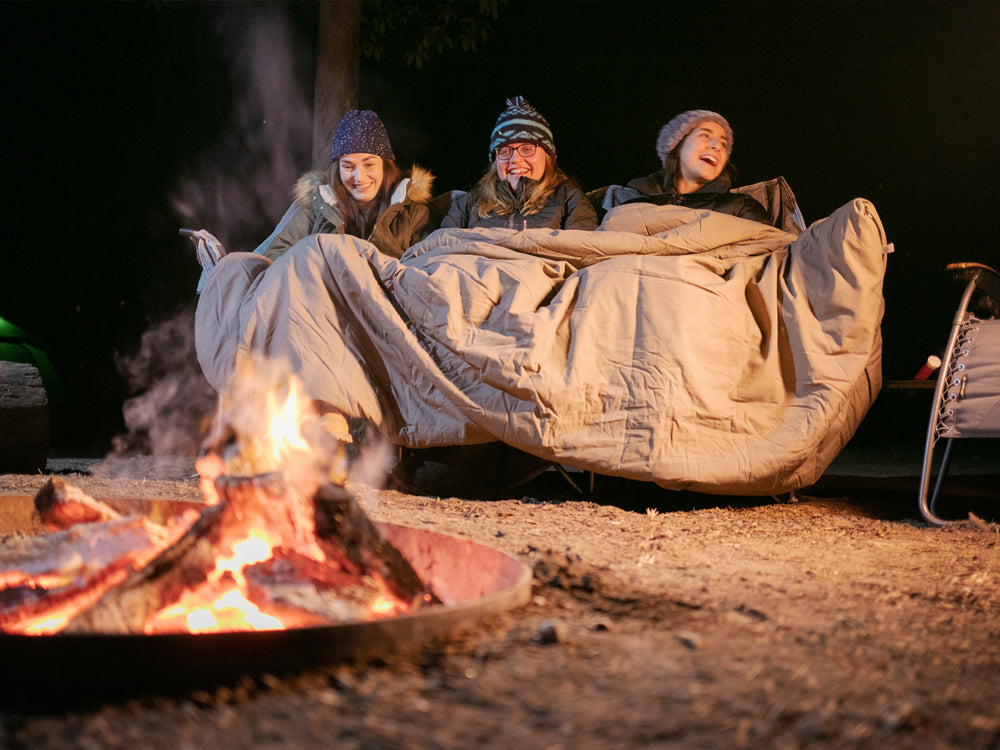Winter camping can be a great way to enjoy the outdoors in a new and different way. The cold weather can drive away crowds, leaving you with more solitude and stunning views. Plus, the dry, cool air often creates ideal conditions for stunning sunsets!
However, winter camping does also pose some unique challenges, especially how to keep warm and dry.
Here are 11 tips to help you have a safe and enjoyable winter camping trip.

1
Check the Weather
As with any outdoor activity, it is important to be prepared for the weather you are likely to encounter on your camping trip.
Check the forecast before you leave with local radio, newspapers, or a weather app and pack appropriately.
Remember that conditions can change quickly, so be prepared for anything. It's always best to pack for the worst-case scenario than to be underprepared and have a miserable time because you're too cold or wet.
Some things to keep in mind when checking the weather forecast include the temperature, the precipitation or chance of rain/snow, the wind, and the chance of storms.

2
Choose the right Campsite
It doesn't matter whether you are backpacking or tent camping, the right campsite can make a huge difference between whether you have a cozy, winter trip or a miserable and cold camp.
Look for a campsite that is sheltered from the wind. It could be next to some trees, or a hill, but make sure you aren't under any dead or dying trees that may break off the trees and crash through your tent.
Also look out for areas that are prone to flooding and try to stay in higher areas.

3
Dress in Layers
One of the biggest tricks to staying warm outdoors during winter is to remain warm and dry. You need to regulate your body temperature so that you're never too hot and sweaty, but also never too cold that your core body temperature drops too low. The best way to achieve this is to dress in layers so that you can quickly add or remove clothing if needed.
There are 3 main layers of clothing:
Baselayer which is the layer closest to your body. The main purpose of this layer is to move moisture away from your body to keep you dry, and to sit tight against your skin to retain your body heat.
This layer could include woollen (or polypro) thermals, beanies, and socks.
Midlayer which is usually an additional insulating layer to retain your body heat, but also helps to allow air to circulate to prevent overheating.
This layer could be a fleece jacket, down puffer jacket, or another heavier thermal layer. (or a combination of these if it's cold enough!)
Outer layer which is also known as the shell layer and includes rainjackets and pants that offer protection from wind and moisure. If there is any chance of rain or snow then a waterproof shell is a must!

4
Sleep in the right clothes
This is a simple one. Even if it's freezing out and you just want to get into your cozy, warm sleeping bag, you should always change into dry, clean clothes before you go to sleep.
If your clothes are dry you will stay warmer at night, and dirty clothes may not keep you as insulated as clean clothes, also it just feels better..!
5
Pack the proper Tent
There are a few criteria here, some commonly talked about ones, and a few, sometimes neglected points.
-
Choose a tent that has enough room to store your gear inside it.
There's nothing worse than finally getting cozy and warm in your tent, to then have to get out of your tent to get something you forgot. -
Choose a four-season tent for winter camping
A 3-season tent will be fine for most warm and mild conditions, however there are a few big benefits to using a 4-season tent in colder climates. - They usually feature a full material inner tent that is designed to keep the tent warmer and the cold air out.
- They are designed to withstand strong winds and heavy rain or snow (however be careful here if you're expecting decent snowfall, be sure it is a true 4-season tent that can shed snow)
- They can also have a lower cut fly which also helps to reduce drafts and keep cold winds out of the tent.
-
Choose a tent that is bigger than you need
It can be handy to bring a 3-person tent to sleep only 2 people for example, as it means you will have plenty of room inside the tent to store your gear.

6
Choose the right Sleeping Bag
Sleeping bag temperature ratings are a good starting point, but they are not always accurate.
Many factors can affect your body temperature at night, such as whether you're a warm or cold sleeper, the number of calories you consume before bed, and the humidity of the air. As a result, it is a good idea to choose a sleeping bag that is rated lower than the coldest temperature you expect to encounter. It is always easier to unzip the bag to cool down than it is to warm up!
You can also use a sleeping bag liner to add additional warmth.
When choosing a sleeping bag, you will need to consider the type of insulation, the shape of the bag, and the weight of the bag.
Down insulation is lightweight and efficient at keeping you warm, but it loses its effectiveness when wet.
Synthetic insulation is heavier than down, but it will keep you warm even if it gets wet.
There are also sleeping bags that are filled with water-resistant down, which gives you the best of both worlds.
The shape of the sleeping bag is also important. Mummy-shaped bags are more efficient at keeping you warm, but they can be restrictive. Rectangular bags are more spacious, but they are not as warm.
Finally, you will need to consider the weight of the sleeping bag. If you are backpacking, you will want to choose a lightweight bag. However, if you are car camping, you can choose a heavier bag that is warmer, more comfortable, and has more room.

7
Insulate yourself from the ground
Sleeping on the cold ground is one of the biggest causes of heat loss while camping. To prevent this the best option is to use two sleeping mats: a closed-cell foam mat underneath and a comfy, inflatable mat on top.
Closed-cell foam mats are very good at insulating, while (self)inflatable mats are more comfortable. Try to steer away from your traditional airbeds as they usually offer no thermal protection, whereas self-inflating mats are one of the better options as the foam inside the mat helps to protect you from the cold ground. There are also some hiking air mats that have insulation (some even have down) which also offer great thermal protection.
The R-value of a sleeping mat is a measure of its insulation, with higher R-values being better. A good average R-value for a sleeping mat is 4.
In addition to using two sleeping pads, you can also spread a ground cloth or tarp under your tent to prevent moisture from forming inside. This will help to keep your sleeping gear dry and comfortable.

8
Consume plenty of Calories
When planning your meals for camping, make sure they are high in calories. Your body needs to burn calories to stay warm, so it is important to eat foods that will provide you with plenty of energy. Simple, one-pot meals are ideal for camping, as they are easy to prepare and clean up.
It is also important to stay hydrated while camping, especially in cold weather. Hypothermia can occur when your body temperature drops too low, and drinking plenty of water can help to prevent this. A stove is also a must-have for camping, as it allows you to make hot drinks and food.
Hot chocolate or another warm drink can help to warm someone up quickly if they are experiencing hypothermia.
Some additional tips for planning your camping meals include
- Pack foods that are high in calories and fat, such as nuts, seeds, dried fruits, and meats
- Choose foods that are easy to digest, such as rice, pasta, and potatoes
- Pack foods that are versatile, so you can make different meals with them
- Pack foods that are lightweight and easy to pack

9
Handwarmers/Heatpacks/Heaters
A simple and effective way to stay warm at night is to use a hot water bottle. If you forgot to bring your water bottle you can simply fill a plastic bottle with hot water (but not so hot that it will burn you) and place the bottle near your feet or between your legs inside your sleeping bag. The heat from the water will help to keep you warm throughout the night.
You can also use handwarmers to warm your hands and feet. You can also slip a handwarmer or two in your sleeping bag just before you go to bed so you are welcomed with a cozy warm bed. Disposable handwarmers are available at most camping stores and chemists and offer a good amount of heat usually for up to 8 hours, reusable handwarmers can also be found which don't offer as much heat but can be "re-set" and used again and again..
Gas heaters are another option for staying warm while camping. They are available in a variety of sizes and styles, and they can be used to heat tents, cabins, and other outdoor spaces.
Most gas heaters won't be safe to use in a tent or other enclosed spaces, but there are some new 'ducted' gas heaters on the market which allow you to warm the tent. There are also some portable diesel heaters out there which provide another good option.
Gas heaters are generally safe to use, but it is important to follow the manufacturer's instructions carefully.

10
Don't run out of power
Batteries can lose power in cold weather, especially alkaline batteries. If your batteries die, you can try warming them in your hands or in your sleeping bag. This might jumpstart them again. However, it is important to note that this is not always effective, and it can be dangerous to warm batteries too much.
If you are going to warm batteries, it is important to do so carefully. Do not use a stove or other heat source that could cause the batteries to overheat. It is also important to keep the batteries away from your skin, as they can cause burns if they are too hot.
11
Bonus tips!
Here are a few extra tips for winter camping:
- When you need to use the bathroom, do it as soon as possible. An empty bladder will help you stay warm by conserving energy
- If you use water bottles, store them upside down at night. Water freezes from the top down, so this will help keep the water from freezing solid
- Be prepared for emergencies by bringing a first-aid kit, extra food and water, and a way to signal for help
- Bring a headlamp or torch, it gets dark quicker in winter and can be very dark at night
- Bring a shovel to clear snow from your campsite and make a path to the bathroom
- Leave no trace by packing out all of your trash and leaving the area as you found it
- Be aware of wildlife in the winter, as it is a good time to see animals. Take precautions to avoid encounters with animals
- Have fun! Winter camping can be a great way to experience the outdoors in a new way!







Leave a comment